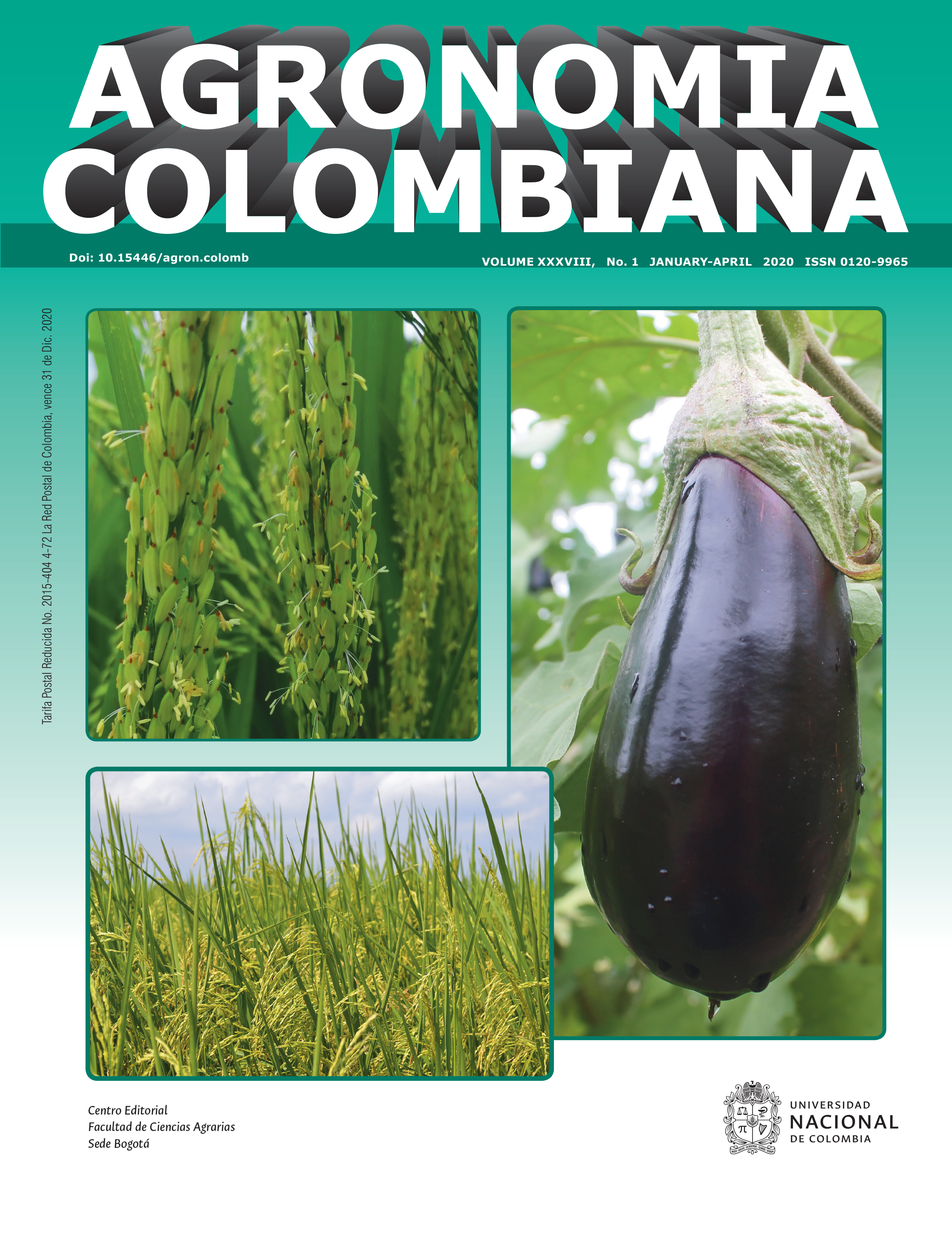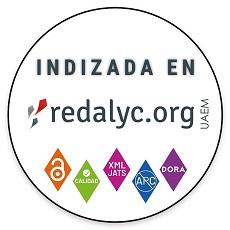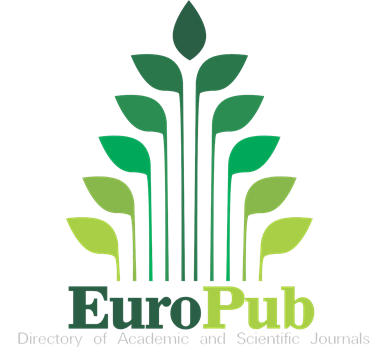Closing yield gaps in Colombian direct seeding rice systems: a stochastic frontier analysis
Cierre de brechas de rendimiento en los sistemas colombianos de siembra directa de arroz: un análisis de frontera estocástica
DOI:
https://doi.org/10.15446/agron.colomb.v38n1.79470Keywords:
empirical models, food security, increasing rice demand, production function, technical efficiency (en)modelos empíricos, seguridad alimentaria, aumento de la demanda de arroz, función de producción, eficiencia técnica (es)
Downloads
Rice is one of the most important crops in terms of harvested area and food security both globally and for Colombia. Improvement of technical efficiency levels in rice production in order to close yield gaps in a context in which rice demand increases, natural resources are depleted, and where there are growing expectations about both climate changes and trade agreements is likely the most important challenge that farmers confront. This research assessed the main management factors that limit both rice crop productivity and the likely drivers of non-optimal technical efficiency levels (a proxy for yield gaps). This study focused on both upland and irrigated direct seeding systems across a variety of environments in Colombia. Stochastic frontier models were used to integrate microeconomic theory and empirical regression analysis in conjunction with a large commercial rice production database developed by the Colombian rice growers’ federation (Fedearroz). A large variation was found in technical efficiency (from 40 to 95%) levels for both upland and irrigated systems, and major differences were obtained in the limiting factors of the two systems (e.g. seed availability, variety type, market accessibility, fertilizer type, and use rate). This suggests both substantial and varied opportunities for improvements in current technical efficiency levels. Across systems, the correct choice of variety was identified as a common key factor
for maximizing yield for a particular environment. For upland systems, optimal choices were F174 and F2000, whereas for irrigated rice F473 was found to produce the highest yield. Additionally, numerical analysis suggests a yield impact of ca. 0.18% for each 1% increase in the nitrogen application rate for upland systems. For irrigated rice, phosphorous rather than nitrogen application rates were found to be more important. Since our analysis is based on farm-scale commercial production data, we argue that once our results are brought to consensus with local extension agents, technicians and agronomists, then management recommendations for closing yield gaps can be used to improve rice productivity.
variadas para mejorar los niveles actuales de eficiencia técnica. En todos
los sistemas, la elección correcta de la variedad se identificó como un factor clave común para maximizar el rendimiento por ambiente. Para los sistemas de tierras altas, las opciones óptimas fueron F174 y F2000, mientras que para el arroz de riego se encontró que F473 era el de mayor rendimiento. Además, el análisis numérico sugiere un impacto en el rendimiento de ca. 0.18% por cada 1% de aumento en la tasa de aplicación de nitrógeno para sistemas de tierras altas. Para el arroz de riego, se encontró que las tasas de aplicación de fósforo en lugar de nitrógeno eran más importantes. Como nuestro análisis se basa en datos de producción comercial a escala de finca, se argumentó que una vez que nuestros resultados llegan a un consenso con los agentes de extensión, técnicos y agrónomos locales, las recomendaciones de gestión para cerrar las brechas de rendimiento se pueden utilizar para mejorar la productividad del arroz.
References
Aigner, D., C.A.K. Lovell, and P. Schmidt. 1977. Formulation and estimation of stochastic frontier production function models. J. Econometrics 6, 21-37. Doi: 10.1016/0304-4076(77)90052-5
Bhatia, V.S., P. Singh, S.P. Wani, G.S. Chauhan, A.V.R.K. Rao, A.K. Mishra, and K. Srinivas. 2008. Analysis of potential yields and yield gaps of rainfed soybean in India using CROPGROSoybean model. Agric. For. Meteorol. 148, 1252-1265. Doi: 10.1016/j.agrformet.2008.03.004
Chang, H.H. and F.I. Wen. 2011. Off-farm work, technical efficiency, and rice production risk in Taiwan. Agric. Econ. 42, 269-278. Doi: 10.1111/j.1574-0862.2010.00513.x
Coelli, T. and A. Henningsen. 2013. Frontier: stochastic frontier analysis. R package version 1.1-0. URL: https://CRAN.RProject.org/package=frontier (accessed July 2018).
DANE. 2004. Encuesta Nacional Agropecuaria. URL: https://www.dane.gov.co/files/investigaciones/boletines/ena/Bolet_Arroz_2004.pdf (accessed July 2018).
DANE. 2016. Statistical database. URL: https://www.dane.gov.co/files/investigaciones/agropecuario/censo-nacional-arrocero/boletin-tecnico-4to-censo-nacional-arrocero-2016.pdf (accessed July 2018).
Delerce, S., H. Dorado, A. Grillon, M.C. Rebolledo, S.D. Prager, V.H. Patiño, G. Garcés-Varón, and D. Jiménez. 2016. Assessing weather-yield relationships in rice at local scale using data mining approaches. PLOS One 11(89), e0161620. Doi: 10.1371/journal.pone.0161620
Esquivel, A., L. Llanos-Herrera, D. Agudelo, S.D. Prager, K. Fernandes, A. Rojas, J.J. Valencia, and J. Ramirez-Villegas. 2018. Predictability of seasonal precipitation across major crop growing areas in Colombia. Clim. Serv. 12, 36-47. Doi: 10.1016/j.cliser.2018.09.001
FAO. 2004. Rice and yield gap reduction, International rice year. Rome. URL: http://www.fao.org/3/Y5167E/y5167e02.htm (accessed July 2018).
FAO. 2010. The state of food insecurity in the world. Rome. URL: http://www.fao.org/publication /sofi/2010/en/ (accessed July 2018).
Foley, J.A., N. Ramankutty, K.A. Brauman, E.S. Cassidy, J.S. Gerber, M. Johnston, N.D. Mueller, C. O’Connell, D.K. Ray, P.C. West, C. Balzer, E.M. Bennett, S.R. Carpenter, J. Hill, C. Monfreda, S. Polasky, J. Rockstrom, J. Sheehan, S. Siebert, D. Tilman, and D.P.M. Zaks. 2011. Solutions for a cultivated planet. Nature 478, 337-342. Doi: 10.1038/nature10452
Fujisaka, S., L. Harrington, and P. Hobbs. 1994. Rice-Wheat in South Asia: systems and long-term priorities established through diagnostic research. Agric. Syst. 46, 169-187. Doi: 10.1016/0308-521X(94)90096-X
Heinemann, A.B., C. Barrios-Pérez, J. Ramírez-Villegas, D. Arango-Londoño, O. Bonilla-Findji, J.C. Medeiros, and A. Jarvis. 2015. Variation and impact of drought-stress patterns across upland rice target population of environments in Brazil. J. Exp. Bot. Doi: 10.1093/jxb/erv126
ISRIC. 2014. World soil Information database. URL: https://soilgrids.org/#!/?layer=ORCDRC_M_sl2_250m&vector=1 (accessed August 2018).
Jiménez, D., J. Cock, H.F. Satizábal, M.A. Barreto, A.A. Pérez-Uribe, A. Jarvis, and P. Van Damme. 2009. Analysis of Andean blackberry (Rubus glaucus) production models obtained by means of artificial neural networks exploiting information collected by small-scale growers in Colombia and publicly available meteorological data. Comput. Electron. Agric. 69, 198-208. Doi: 10.1016/j.compag.2009.08.008
Jiménez, D., J. Cock, A. Jarvis, J. Garcia, H.F. Satizábal, P. Van Damme, A. Pérez-Uribe, and M.A. Barreto-Sanz. 2011. Interpretation of commercial production information: a case study of lulo (Solanum quitoense), an under-researched Andean fruit. Agric. Syst. 104, 258-270. Doi: 10.1016/j.agsy.2010.10.004
Julia, C. and M. Dingkuhn. 2013. Predicting temperature induced sterility of rice spikelets requires simulation of crop-generated microclimate. Eur. J. Agron. 49, 50-60. Doi: 10.1016/j.eja.2013.03.006
Khoury, C.K., A.D. Bjorkman, H. Dempewolf, J. Ramirez-Villegas, L. Guarino, A. Jarvis, L.H. Rieseberg, and P.C. Struik. 2014. Increasing homogeneity in global food supplies and the implications for food security. Proc. Natl. Acad. Sci. U.S.A. 111, 4001-6. Doi: 10.1073/pnas.1313490111
Kumbhakar, S.C. and K. Lovell. 2000. Stochastic frontier analysis. Cambridge Univeristy Press, Cambridge, UK. Doi: 10.1111/1467-8276.t01-1-00317
Licker, R., M. Johnston, J.A. Foley, C. Barford, C.J. Kucharik, C. Monfreda, and N. Ramankutty. 2010. Mind the gap: how do climate and agricultural management explain the “yield gap” of croplands around the world? Glob. Ecol. Biogeogr. 19, 769-782. Doi: 10.1111/j.1466-8238.2010.00563.x
Lipper, L., P. Thornton, B.M. Campbell, T. Baedeker, A. Braimoh, M. Bwalya, P. Caron, A. Cattaneo, D. Garrity, K. Henry, R. Hottle, L. Jackson, A. Jarvis, F. Kossam, W. Mann, N. McCarthy, A. Meybeck, H. Neufeldt, T. Remington, P.T. Sen, R. Sessa, R. Shula, A. Tibu, and E.F. Torquebiau. 2014. Climate-smart agriculture for food security. Nat. Clim. Chang. 4, 1068-1072. Doi: 10.1038/nclimate2437
Lobell, D.B., K.G. Cassman, and C.B. Field. 2009. Crop yield gaps: their importance, magnitudes, and causes. Annu. Rev. Environ. Resour. 34, 179-204. Doi: 10.1146/annurev.environ.041008.093740
Longstreth, D.J. and P.S. Nobel. 1980. Nutrient influences on leaf photosynthesis. Plant Physiol. 65, 541-543. Doi: 10.1104/pp.65.3.541
Llanos, L. and D. Arango. 2015. RClimTool: a free application for analyzing climatic series. Working Paper International Center for Tropical Agriculture. URL: https://cgspace.cgiar.org/handle/10568/63482 (accessed August 2018).
MADR. 2012. Anuario estadístico del sector agropecuario 2012. URL: https://www.agronet.gov.co/Noticias/Paginas/Noticia842.aspx (accessed July 2018).
Mueller, N.D., J.S. Gerber, M. Johnston, D.K. Ray, N. Ramankutty, and J.A. Foley. 2012. Closing yield gaps through nutrient and water management. Nature 490, 254-257. Doi: 10.1038/nature11420
Mythili, G. and K.R. Shanmugam. 2000. Technical efficiency of rice growers in Tamil Nadu: a study based on panel data. Indian J. Agric. Econ. 55, 15-25. Doi: 10.22004/ag.econ.297715
Nagai, T. and A. Makino. 2009. Differences between rice and wheat in temperature responses of photosynthesis and plant growth. Plant Cell Physiol. 50, 744-55. Doi: 10.1093/pcp/pcp029
Pardo, C.E. and C. Del Campo. 2007. Combinación de métodos factoriales y de análisis de conglomerados en R: el paquete FactoClass. Rev. Colomb. Estad. 30, 231-245.
Peng, S., J. Huang, J.E. Sheehy, R.C. Laza, R.M. Visperas, X. Zhong, G.S. Centeno, G.S. Khush, and K.G. Cassman. 2004. Rice yields decline with higher night temperature from global warming. Proc. Natl. Acad. Sci. U.S.A. 101, 9971-9975. Doi: 10.1073/pnas.0403720101
Perdomo, J. and J. Mendieta. 2007. Factores que afectan la eficiencia técnica y asignativa en el sector cafetero colombiano: una aplicación con análisis envolvente de datos. Desarrollo y Sociedad 2007-II, 1-45.
Perdomo, J. and D. Hueth. 2011. Funciones de producción y eficiencia técnica en el eje cafetero colombiano: una aproximación con frontera estocástica. Rev. Colomb. Estad. 34, 377-402. Doi: 10.22004/ag.econ.100873
R Core Team. 2017. R: a language and environment for statistical computing. R Foundation for Statistical Computing, Vienna, Austria.
Tian, W. and G.H. Wan. 2000. Technical Efficiency and Its Determinants in China’s Grain Production. J. Product. Anal. 13, 159-174. Doi: 10.1023/A:1007805015716
Tilman, D. and M. Clark. 2014. Global diets link environmental sustainability and human health. Nature 515, 518-522. Doi: 10.1038/nature13959
UN. 2010. World Population Prospects: The 2010 Revision URL: https://www.oecd-ilibrary.org/content/publication/08b807d4-en (accessed July 2018).
Van Bussel, L.G.J., P. Grassini, J. Van Wart, J. Wolf, L. Claessens, H. Yang, H. Boogaard, H. de Groot, K. Saito, K.G. Cassman, and M.K. van Ittersum. 2015. From field to atlas: upscaling of location-specific yield gap estimates. F. Crop. Res. 177, 98-108. Doi: 10.1016/j.fcr.2015.03.005
Van Wart, J., L.G.J. van Bussel, J. Wolf, R. Licker, P. Grassini, A. Nelson, H. Boogaard, J. Gerber, N.D. Mueller, L. Claessens, M.K. van Ittersum, and K.G. Cassman. 2013. Use of agro-climatic zones to upscale simulated crop yield potential. F. Crop. Res. 143, 44-55. Doi: 10.1016/j.fcr.2012.11.023
Villano, R. and E. Fleming. 2004. Analysis of technical efficiency in rainfed lowland rice environment in Central Luzon Philippines using stochastic frontier production function with heteroskedastic error structure. Working paper series in Agricultural and Resource Economics. University of New England, Armidale, Australia. Doi: 10.22004/ag.econ.12906
West, P.C., J.S. Gerber, P.M. Engstrom, N.D. Mueller, K.A. Brauman, K.M. Carlson, E.S. Cassidy, M. Johnston, G.K. MacDonald, D.K. Ray, and S. Siebert. 2014. Leverage points for improving global food security and the environment. Science 345, 325-328. Doi: 10.1126/science.1246067
Wheeler, T. and J. von Braun. 2013. Climate change impacts on global food security. Science 341(6145), 508-513. Doi: 10.1126/science.1239402
Xua, X. and S.R. Jeffrey. 1998. Efficiency and technical progress in traditional and modern agriculture: evidence from rice production in China. Agric. Econ. 18, 157-165. Doi: 10.1111/j.1574-0862.1998.tb00495.x
How to Cite
APA
ACM
ACS
ABNT
Chicago
Harvard
IEEE
MLA
Turabian
Vancouver
Download Citation
CrossRef Cited-by
1. Soenke Ziesche, Swati Agarwal, Uday Nagaraju, Edson Prestes, Naman Singha. (2023). The Ethics of Artificial Intelligence for the Sustainable Development Goals. Philosophical Studies Series. 152, p.379. https://doi.org/10.1007/978-3-031-21147-8_21.
2. Sudha Shanmugam, Stanley Omar P. B. Samonte, Darlene L. Sanchez, Jonalyn C. Yabes. (2025). Genetic assessment of diverse rice germplasm for yield-related and stress tolerance traits. Genetic Resources and Crop Evolution, 72(1), p.885. https://doi.org/10.1007/s10722-024-02004-4.
Dimensions
PlumX
Article abstract page views
Downloads
License
Copyright (c) 2020 Agronomía Colombiana

This work is licensed under a Creative Commons Attribution-NonCommercial-ShareAlike 4.0 International License.
© Centro Editorial de la Facultad de Ciencias Agrarias, Universidad Nacional de Colombia
Reproduction and quotation of material appearing in the journal is authorized provided the following are explicitly indicated: journal name, author(s) name, year, volume, issue and pages of the source. The ideas and observations recorded by the authors are their own and do not necessarily represent the views and policies of the Universidad Nacional de Colombia. Mention of products or commercial firms in the journal does not constitute a recommendation or endorsement on the part of the Universidad Nacional de Colombia; furthermore, the use of such products should comply with the product label recommendations.
The Creative Commons license used by Agronomia Colombiana journal is: Attribution - NonCommercial - ShareAlike (by-nc-sa)

Agronomia Colombiana by Centro Editorial of Facultad de Ciencias Agrarias, Universidad Nacional de Colombia is licensed under a Creative Commons Reconocimiento-NoComercial-CompartirIgual 4.0 Internacional License.
Creado a partir de la obra en http://revistas.unal.edu.co/index.php/agrocol/.





















